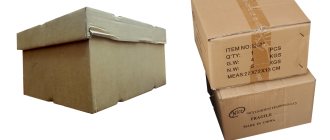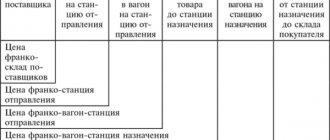- Consumer packaging
The term “packaging” refers to the means (materials, objects, devices) that form a certain shell around the product and provide appropriate conditions for its storage, transportation and use.
In this article we will look at some historical aspects of the evolution of packaging, its functions and classification.
Let's start with functions, because they determine the properties, appearance, design features and the very essence of packaging as an integral part of human culture.
Packaging functions
Protective function
Packaging provides protection:
- from mechanical influences
- from climate impacts
- from biological threats
- from social threats
Shocks, friction, pressure, vibration, everything that can cause harm to the contents is stopped by proper packaging. In this case, not only the outer shell plays an important role, but also specially designed internal inserts and supports.
Moisture, temperature changes, and ultraviolet rays can affect the contents of the package. Also, some products are characterized by the accumulation of internal moisture. Moisture-resistant materials, thermal insulation and hygroscopic (for example, silica gel) liners solve this problem.
The packaging prevents unwanted contact of the contents with animals, insects and microorganisms (sealed, sterile packaging).
Packaging is often equipped with tamper evident devices (for example, a device for sealing, the most primitive being sealing stickers). But often disposable packaging itself is a means of tampering; for example, an ordinary plastic bag, once opened, cannot be repackaged.
Optimizing function
The packaging optimizes space as follows:
- groups and organizes goods that consist of several items. Various sets, children's construction set, instant noodles with seasoning and oil, mobile phone with instructions, charger and other components. Actually, any kits.
- gives shape and final volume to bulk, liquid and gaseous contents Flour, sugar, cement, nails packaged in bags, water, wine, various chemicals bottled, acetylene, oxygen in cylinders, all this would simply be impossible to store without packaging , neither transport nor, in some cases, use.
Also, packaging optimizes processes:
- logistics optimization Packaging is designed in such a way as to simplify transportation as much as possible. Consumer packaging is often equipped with carrying devices (handles, holes). Transport containers are equipped with loops for slinging, holes and openings for working with a forklift, for securing on platforms, etc. Thoughtful packaging contributes to the long-term preservation of goods. For this purpose, optimal storage conditions are created inside the package, from temperature to vacuum, depending on the requirements. The design of packaging and storage containers is developed for its rapid formation and the most comfortable storage when folded, as well as for performing other logistics operations.
- optimization of use Depending on the properties of the contents and the conditions of its use, packaging can be adapted for consumer or industrial purposes, as well as for maximum convenience of its use in the process of trade and use by the end consumer.
- accounting optimization Packing goods into packaging simplifies accounting. For example, the most common packaging of flour for sale by weight and use in small industries is 50 kg. Thus, by counting the bags in the warehouse, you can judge the inventory balance without weighing.
Consumer packaging is equipped with means that allow it to be unpacked and closed again, thus ensuring the possibility of storing the product during its use. Often, consumer packaging is a product of engineering that allows not only to preserve the product until it is unpacked, but also to facilitate its use throughout its entire life cycle. An example is a package for a safety razor, which, after unpacking, turns into a stand and at the same time a case for replacement shaving heads.
Commercial and industrial containers are equipped with a variety of devices for dosing, filling control, loading and unloading. For example, octabins for bulk and liquid cargo are equipped with drain taps and valves, cable containers are equipped with a cradle-drum for unwinding the coil, containers for the sales area are equipped with perforations, allowing the wall height to be reduced as it is emptied.
Information function
The packaging may contain the following information:
- information about the contents Product name, model, serial number, grade, net/gross weight, method of use.
- information about the composition List of ingredients and the percentage of some of them, or packaging.
- advertising information Brand name and logo, slogan, brief description of advantages, information about the manufacturer, brand legend, etc.
- logistics information Necessary storage and transportation conditions, warnings (for example, “do not tip”, “do not throw”, “do not stack in more than 2 tiers”, etc. “) Often such information is presented in the form of special pictograms, they are called “ manipulation signs."
- Disposal information Some types of products require special conditions for disposal (for example, batteries, mercury thermometers or daylight sources). Also, the packaging itself can be disposed of in one way or another. Packaging made from recycled materials and recyclable is also often marked with certain pictograms.
Packaging equipment
A special type of transport packaging are pallets and containers, called packaging equipment. This includes box pallets in which goods are delivered from manufacturing plants and warehouses directly to the sales floors of self-service retail stores. The use of packaging equipment creates great convenience both when transporting products and when selling them.
In the sales area, such a box pallet plays the role of commercial equipment and replaces racks, counters, and sales shelves. This allows us to eliminate a very labor-intensive link in the distribution chain - the selection of goods in the warehouse according to orders from retail stores; this work is shifted in this case to the buyers themselves. A number of other operations are also eliminated: laying out goods on shelves and counters, putting prices on them, which leads to faster delivery of goods, lower distribution costs, reduced losses from damage to goods and, ultimately, to increased profits in trade.
The use of pallets is very convenient in the trade of vegetables, fruits, meat, fish, therefore they are used in the food industries of the agro-industrial complex, as well as in the textile, chemical, and perfume industries. The pallets are easily stacked both in working and folded form, are characterized by low dead weight and high durability, and are easily sterilized with hot water and steam.
History of packaging
The first packaging was made from the most primitive natural materials. Primitive man was constantly nomadic and he needed, one way or another, to carry his belongings and supplies. This is how the first packaging materials appeared - skins in which cargo was wrapped to carry and protect it from rodents, vines for tying cargo, etc. Then they naturally transformed into more advanced devices that can already be called full-fledged containers - bags made from skins using sinews, baskets woven from bark and flexible branches.
The transition from the use of natural materials in their natural form to the manufacture of simple carrying devices marked a huge step in the development of mankind. It is difficult to overestimate him. In fact, the inventor of the bag contributed no less to the history of transportation than his colleague who later created the wheel.
One of the most difficult tasks was carrying water, and, before the advent of pottery, baskets coated with clay were used for this purpose, thus marking the advent of primitive combination packaging.
Later, dried pumpkins and vessels hollowed out of solid wood began to be used for liquids. At the same time, the first wineskins made from tanned skins appeared.
With the development of crafts, packaging is becoming more and more advanced. It is still based on natural materials, but the result becomes technologically more efficient. Thus, a sedentary way of life, animal husbandry, and the cultivation of plant crops determined the emergence of high-quality fabrics from plant fibers and wool, which replaced skins (but did not completely replace them), pottery opened a new chapter in the creation of containers for liquid cargo, and the invention of paper gave birth to simply unlimited scope for experiments with packaging. Suffice it to say that paper with its derivatives (cardboard, corrugated cardboard) is still one of the most common and in demand packaging materials today.
As new technologies were mastered, the variety of types of packaging grew, and various combinations of materials were introduced into everyday life. Glassblowing itself represented a giant step in the evolution of packaging solutions. The remarkable properties of glass, such as water resistance, resistance to active media and plasticity during the blowing process, transparency, made it possible to make vessels of any shape, capacity and purpose from it, from miniature bottles for potions to giant wine bottles. But the proverbial fragility of glass required the development of combined solutions. This is how cases for perfume bottles and braided bottles appeared, which are still actively used today, for example, in traditional winemaking, or when packaging valuable types of vegetable oils.
The era of metals could not but influence the packaging industry. Wooden chests, which previously dominated the market for frame containers, being bound with iron, turned into strong chests for valuables. Metal hinges replaced leather hinges, and mechanical locks made it possible to create the prototypes of modern safes. Thus, the development of packaging gave rise to a separate branch, which was intertwined with the history of furniture.
In general, packaging has changed little from the Middle Ages to modern times. Wooden boxes, paper bags, metal, clay and glass vessels changed slightly, largely due to the improvement and cheaper methods of their production, but fundamentally remained the same as in the times of the pharaohs or King Arthur.
Chemistry opened a new chapter in the history of packaging. When humanity learned to synthesize materials with specified properties, packaging changed dramatically. The emergence of a whole range of polymers, the production of synthetic fibers and adhesives on an industrial scale has made it possible to take a fresh look at classic forms. Plastic bottles and flasks have significantly replaced glass in the field of consumer packaging. Unbreakable, cheap to manufacture, shock-absorbing, and easily paintable, plastic has become an ideal material for commercial packaging.
And the good old materials have also changed a lot. Take a tree, for example. A thin board is not resistant to fracture, especially along the grain, especially if the wood is not of the highest quality. But if you take three layers of millimeter-thick veneer and glue them together so that the fibers of adjacent layers are perpendicular to each other, you will get plywood - a thin sheet, only three millimeters thick, with extraordinary strength for such a thickness. Or, let's say, paper. Two layers of ordinary paper are laid with a corrugated paper sheet, glued together, and the result is a new material that is simply stunning in its properties, well known to everyone today - corrugated cardboard.
Types of packaging
Packaging can take on a variety of different forms and is endlessly variable in design and composition.
What determines such diversity? The design of the packaging and materials for its manufacture are dictated by the following factors:
- What will be the content;
- Under what conditions will it be used?
- What processes will she participate in?
According to the definition on Wikipedia, packaging has three forms - materials, objects and devices. Let's look at each one separately.
Materials
Materials that themselves can be classified as packaging are usually called packaging. The most common and familiar to almost everyone is wrapping paper. It is used both as a wrapping material and as a filler for containers. In general, most packaging materials play rather a supporting role. Some of them require special equipment (such as shrink film) to be used as packaging.
It is necessary to distinguish between the concepts of “packaging materials” and “materials for packaging production”. Packaging can be made of any material from trivial polyethylene to precious metals. For example, a humidor (cigar case) can be made of valuable wood, say rosewood. But rosewood is in no way a packaging material.
Examples of packaging materials:
- Paper
- Stretch film
- Heat shrink sleeve
- Strapping twine
- Single and double sided tape
- Metal strapping tape
These and other packaging materials can be used both as self-sufficient packaging and as auxiliary elements.
From the materials that are used for packaging in their original form, let’s move on to the packaging itself.
Placement of inscriptions
The rules for transport marking of goods determine the requirements for packaging, the content and order of placement of signs during transportation. Based on the selected type of container, the following can be used:
- stamping;
- branding;
- stencil;
- litho- and printing houses;
- electrolytic method;
- hardware embossing.
Markings on containers must comply with ISO 6346 standards.
The location of the inscriptions is determined by the packaging form:
- When using boxes, one of the faces is used for placement. The presence of sheathing or external strips requires additional area to cover free areas and allow markers to be applied.
- In the case of packaging using fabric materials (bags, bales), the cargo for transportation is marked in the upper part, next to the seam, as well as on the side.
- If the object has a barrel shape, one of the covers or a side section of the body is selected for marking.
In the absence of shipping containers, the main inscriptions are placed on a visible part that is easily visible during interaction.
Items
All packaging can be roughly classified into two large groups:
Consumer packaging
This group includes all packaging intended for use by the end consumer. Everything you buy in a store is packaged in consumer packaging.
Some examples of consumer packaging, indicating possible materials:
- bag for chips (cellophane, wax paper);
- currency with tablets (foil, plastic);
- milk bottle (glass, polyethylene);
- box with supports for TV (corrugated cardboard, polystyrene foam);
- cigarette pack (cardboard, foil paper, cellophane);
- case for jewelry (wood, plastic, velvet, satin);
- postcard envelope (paper);
- file for documents (polyethylene).
Industrial, trade and logistics packaging
As the name suggests, this group includes an extensive family of packaging solutions designed for professional applications. Unlike consumer packaging, containers, as a rule (but not always), are developed not for a specific product, but for a whole group of products. Thus, packaging for toothpaste (a tube and a cardboard box with a certain print and a certain size) is suitable only for a specific toothpaste. And the reusable container, in which 10,000 tubes of this paste are delivered from the manufacturing plant to the wholesale base, will be used more than once to transport soap or shampoos.
Some examples of industrial, commercial and logistics packaging:
- port container (metal);
- cable drum (wood, plastic, metal);
- pallet storage container (wood, corrugated cardboard);
- packaging cage (wood, fastening hardware);
- vegetable box (wood, hardware, polyethylene, corrugated cardboard);
- octabin for liquid (corrugated cardboard, polyethylene);
- tank (metal);
Marking
If necessary, markings are applied to the surface of the package indicating the characteristics of the cargo:
- designations regarding any actions with cargo during operation, transportation, loading, unloading;
- designations indicating the material from which the cargo and packaging are made;
- environmental designations - such signs indicate the degree of environmental friendliness of the cargo and packaging, making it easier to sort and dispose of the container at the end of use.
Packaging and containers are presented in a wide range. Each group is designed to work with a specific category of goods and perform specific functions. Cargo transportation is integrally associated with the use of packaging, therefore a certain degree of responsibility for the correct choice and impeccable quality of containers lies with the cargo carrier. The carrier has the right to refuse to transport cargo if it is poorly packaged or the container does not meet the standards and technical requirements.
Basic rules for transporting fragile goods.
Views: 13,038
Devices
Strictly speaking, a device can and should be called any object consisting of more than one part.
An ordinary glass jar with a polyethylene lid is already a device for storing liquids. However, there are individual representatives of the huge family of packaging and containers that clearly deserve the right to be called devices.
Thus, a striking example of an engineering device among consumer packaging is a mechanical case with lipstick or a bottle of window cleaner with a spray bottle.
An example of a production container-device is an acetylene cylinder with a valve and a pressure gauge and a safety valve or a silo-type container with bottom discharge, equipped with a dosing system.
Disposal of packaging
It's no secret that the world today is on the verge of an environmental disaster. And one of the factors influencing pollution is the ill-conceived policies of manufacturers regarding packaging solutions.
Many concepts that demonstrate amazing commercial efficiency turn out to be extremely environmentally unfriendly. The largest packaging manufacturers have already recognized the problem and are announcing competitions with seven-figure sums as prizes for those who offer a practical solution.
Fortunately, there are completely environmentally friendly solutions for many problems. In particular, almost all corrugated cardboard packaging is made from recycled materials and can be recycled at the end of its life cycle. But even if a fragment of a corrugated cardboard box somehow ends up in natural conditions, it will not cause contamination. In 3-4 months it decomposes without a trace, without causing harm to the environment, since it consists of 99.9% cellulose, that is, it is identical in composition to wood. In this case, the decomposition period of wood products ranges from 4 to 10 years.
The packaging industry is such a vast industry that it can be the topic of hundreds of articles, and one long read will not be enough to fully cover all the issues. Therefore, ask. We are always ready to provide you with comprehensive information on any relevant issue [email protected]
ADR documents. Entries in waybills.
The invoice must be written in the official (state) language of the shipper. If this language is not English, French, German, then additionally in one of these languages.
When recording the name of the dangerous goods being transported in the consignment note, the identification number UN... (or ANO...) is indicated first (example: 1831).
Then write down the full name of the dangerous cargo (sulfuric acid).
Then the class of the main hazard is indicated (the number of the main hazard sign is called) and, if there is one, the class of additional hazard (in brackets) (the number of the sign of additional hazard is called) - 8 (6.1), and the packing group, if any, is indicated - I.
Example of a complete entry: UN 1831, sulfuric acid, 8 (6.1), I.
The packaging form, quantity and weight are written in words, for example: UN 1223, kerosene, 3, III (barrels, 10 pieces, 2000 kg).
Empty and uncleaned packaging - examples:
Empty barrels, 3 (6.1).
Empty tanker, last load UN 1230, methanol, 3 (6.1), II.
Empty tanker, last load UN 1203, gasoline, 3, II.
These entries can be made by the driver himself anywhere in the copy of the last cargo invoice. These entries are required.




